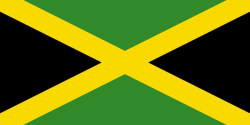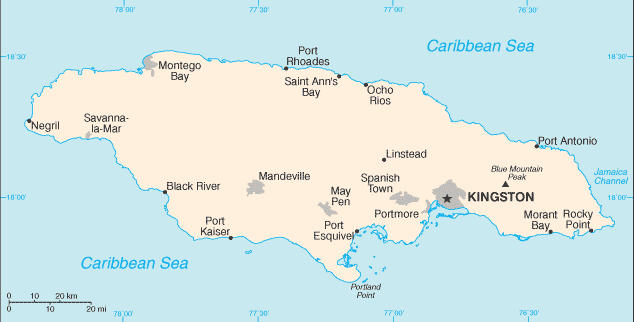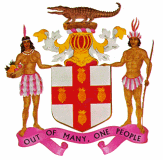Jamaica
Related Categories:
 Flag of Jamaica
Flag of JamaicaDiagonal yellow cross divides the flag into four triangles - green (top and bottom) and black (hoist side and outer side). |


|
Our National Symbols are representative of our rich history and culture. They define us as a people – Jamaicans who are proud of where we are coming from.
www.jis.gov.jm/
The Flag, Alternate History of the Flag, Coat of Arms, Proposals for the Flag, Subdivisions, Political Flags.
www.fotw.us/
The original Arawak or Taino people from South America first settled on the island between 4000 and 1000 BC. Although some claim they became virtually extinct following contact with Europeans, others claim that some survived for a while.
en.wikipedia.org/
Arawaks from South America had settled in Jamaica prior to Christopher Columbus' first arrival at the island in 1494. During Spain's occupation of the island, starting in 1510, the Arawaks were exterminated by disease, slavery, and war. Spain brought the first African slaves to Jamaica in 1517. In 1655, British forces seized the island, and in 1670, Great Britain gained formal possession.
Sugar made Jamaica one of the most valuable possessions in the world for more than 150 years. The British Parliament abolished slavery as of August 1, 1834. After a long period of direct British colonial rule, Jamaica gained a degree of local political control in the late 1930s, and held its first election under full universal adult suffrage in 1944. Jamaica joined nine other U.K. territories in the West Indies Federation in 1958 but withdrew after Jamaican voters rejected membership in 1961. Jamaica gained independence in 1962, remaining a member of the Commonwealth.
Historically, Jamaican emigration has been heavy. Since the United Kingdom restricted emigration in 1967, the major flow has been to the United States and Canada. About 20,000 Jamaicans emigrate to the United States each year; another 200,000 visit annually. New York, Miami, Chicago, and Hartford are among the U.S. cities with a significant Jamaican population. Remittances from the expatriate communities in the United States, United Kingdom, and Canada, estimated at up to $1.6 billion per year, make increasingly significant contributions to Jamaica's economy.
www.state.gov/r/
Introduction
About
Contact
Symbols in The News
Interpret this Symbol
AAC
African
AI
Alchemy
Alphabets
Ancient
Animal Symbolism
Architecture
Art
Articles
Astrology
Baha'i
Blissymbolics
Blueprint Symbols
Buddhist
Celtic Symbols
Cemetery
Chinese Symbols
Christian
Circle
City
Codes
Color
Conlangs
Crop Circles
Danger
Da Vinci Code
Designing Logos
Dictionaries
Dreams
Education
Egyptian Symbols
Electrical
Emoticons
Find Images
Fonts
Food
Fraternity
Hamsa
Healing
Heraldry
Hermetic
Highway Signs
Hindu
History
Hobo
Holiday
Icons
iConji
Islamic
Jain Symbols
Japanese, Kanji
Jewish
Justice
Law
Literary Symbolism
Mandalas
Map
Masonic
Math, Number
Meaning of Names
Medical
Middle East
Military
Miscellaneous
Money
Music
Mythology
Native American
Playing Cards
Power
Psychology
QiQiiKhu
Reiki
Religious
Runes, Norse
Sacred Geometry
Scientific
Science Fiction
Sorority
Sports
Symbols in the News
Tattoos
ThirteenSymbols
Tree of Life
Ursprache
Videos
Visual Languages
Weather
Web Codes
Wicca
Words
Writing Systems
Braille
Coinherence
Coptic
Cuneiform
Easter Island
Etruscan
Happy Human
Hebrew
Kokopelli
Linear B
Lotus
Love Symbols
Mandorla
Moon Alphabet
Nine Pointed Star
Om
Oz
Phonetic
Scarab Beetle
Silent
Theosophy
Unifon
About
Contact
Symbols in The News
Interpret this Symbol
AAC
African
AI
Alchemy
Alphabets
Ancient
Animal Symbolism
Architecture
Art
Articles
Astrology
Baha'i
Blissymbolics
Blueprint Symbols
Buddhist
Celtic Symbols
Cemetery
Chinese Symbols
Christian
Circle
City
Codes
Color
Conlangs
Crop Circles
Danger
Da Vinci Code
Designing Logos
Dictionaries
Dreams
Education
Egyptian Symbols
Electrical
Emoticons
Find Images
Fonts
Food
Fraternity
Hamsa
Healing
Heraldry
Hermetic
Highway Signs
Hindu
History
Hobo
Holiday
Icons
iConji
Islamic
Jain Symbols
Japanese, Kanji
Jewish
Justice
Law
Literary Symbolism
Mandalas
Map
Masonic
Math, Number
Meaning of Names
Medical
Middle East
Military
Miscellaneous
Money
Music
Mythology
Native American
Playing Cards
Power
Psychology
QiQiiKhu
Reiki
Religious
Runes, Norse
Sacred Geometry
Scientific
Science Fiction
Sorority
Sports
Symbols in the News
Tattoos
ThirteenSymbols
Tree of Life
Ursprache
Videos
Visual Languages
Weather
Web Codes
Wicca
Words
Writing Systems
Braille
Coinherence
Coptic
Cuneiform
Easter Island
Etruscan
Happy Human
Hebrew
Kokopelli
Linear B
Lotus
Love Symbols
Mandorla
Moon Alphabet
Nine Pointed Star
Om
Oz
Phonetic
Scarab Beetle
Silent
Theosophy
Unifon
